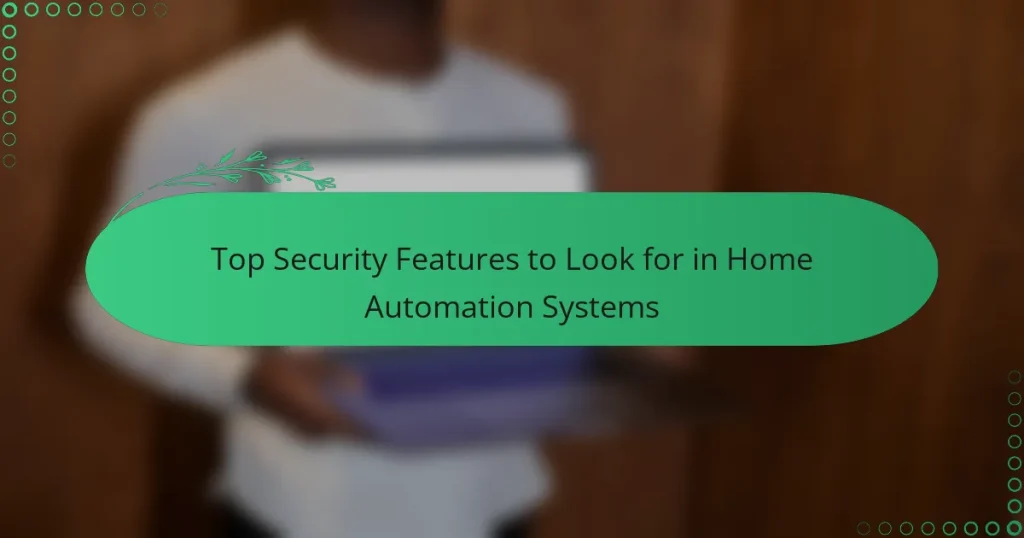When considering home automation systems, it’s essential to prioritize security features that protect your property and enhance your peace of mind. Key elements such as smart locks, surveillance cameras, and motion sensors work together to provide comprehensive security solutions. These technologies allow for remote monitoring and control, ensuring that homeowners can manage access and stay informed about their home’s safety at all times.
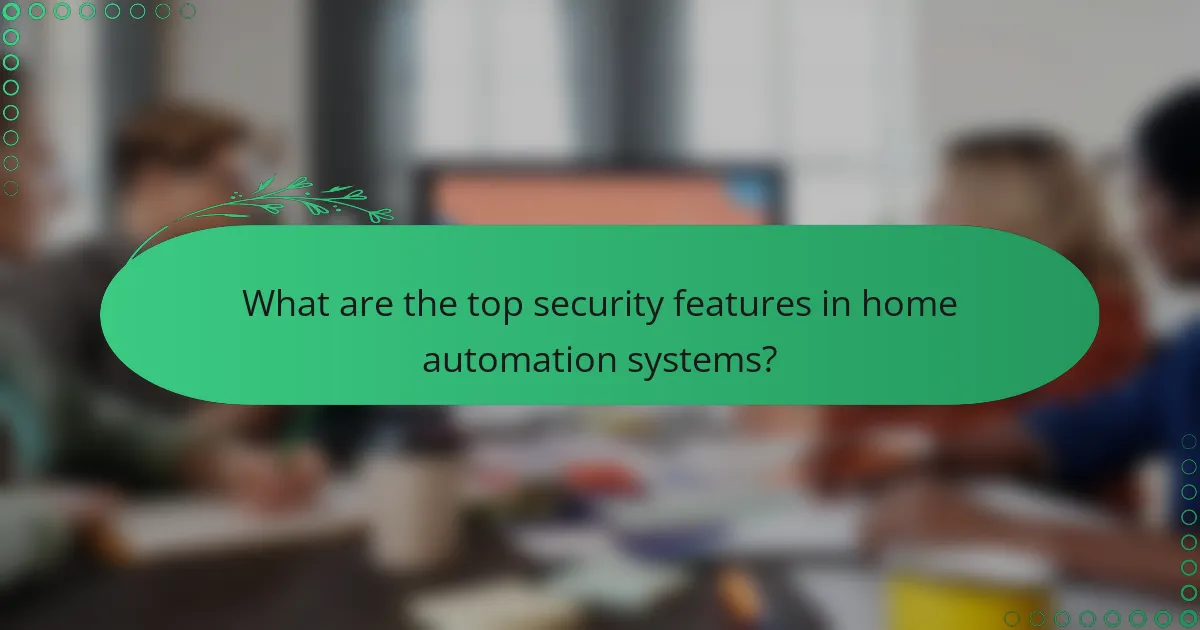
What are the top security features in home automation systems?
The top security features in home automation systems include smart locks, surveillance cameras, alarm systems, motion sensors, and remote monitoring. These elements work together to enhance home security by providing control, visibility, and alerts to homeowners.
Smart locks
Smart locks provide keyless entry and can be controlled remotely via a smartphone app. They often include features like temporary access codes for guests and automatic locking mechanisms, which enhance convenience and security.
When choosing smart locks, consider compatibility with your existing door hardware and the type of connectivity (Wi-Fi, Bluetooth, or Z-Wave). Look for models that offer encryption and two-factor authentication to prevent unauthorized access.
Surveillance cameras
Surveillance cameras allow homeowners to monitor their property in real-time and record footage for later review. Many modern systems offer features like night vision, motion detection, and cloud storage for easy access to video clips.
When selecting cameras, consider resolution (1080p or higher for clarity), field of view, and whether they are indoor or outdoor rated. Ensure they have strong security protocols to protect against hacking.
Alarm systems
Alarm systems serve as a primary deterrent against intrusions, alerting homeowners and authorities in case of a breach. They can be integrated with other smart devices for a comprehensive security solution.
Look for systems that offer 24/7 monitoring, customizable alerts, and easy installation. Some systems allow for self-monitoring via mobile apps, while others provide professional monitoring services for a monthly fee.
Motion sensors
Motion sensors detect movement within a designated area and can trigger alarms or notifications. They are essential for enhancing security by alerting homeowners to unusual activity.
Consider the type of motion sensor: passive infrared (PIR) sensors are common for indoor use, while dual-tech sensors combine PIR and microwave technology for outdoor areas. Ensure they are adjustable to minimize false alarms from pets or environmental factors.
Remote monitoring
Remote monitoring allows homeowners to keep an eye on their property from anywhere using a smartphone or computer. This feature is crucial for peace of mind, especially when away from home.
Look for systems that offer user-friendly apps with real-time alerts and video feeds. Ensure that the system supports secure connections to protect your data and privacy while monitoring your home remotely.
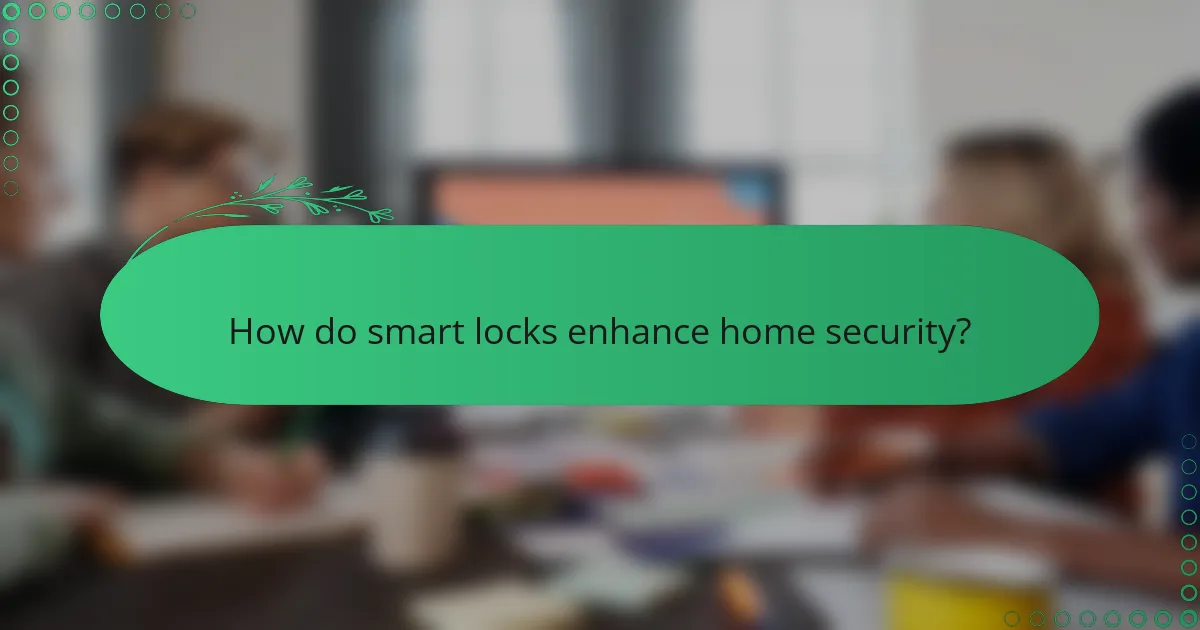
How do smart locks enhance home security?
Smart locks significantly enhance home security by providing advanced locking mechanisms that can be controlled remotely and offer features like keyless entry. They allow homeowners to manage access to their property conveniently while maintaining a high level of security.
Keyless entry
Keyless entry systems eliminate the need for traditional keys, allowing users to unlock doors using smartphones, key fobs, or biometric data like fingerprints. This feature reduces the risk of lost or stolen keys, which can compromise home security.
Many smart locks offer customizable access codes, enabling homeowners to grant temporary access to guests or service providers. This flexibility is particularly useful for short-term rentals or when you need to allow access without being present.
Remote access control
Remote access control allows homeowners to lock or unlock their doors from anywhere using a smartphone app. This feature is crucial for managing access when you’re away from home, as you can grant entry to visitors or service personnel without needing to be physically present.
Some systems also integrate with home automation platforms, enabling users to create schedules or automate locking and unlocking based on their routines. This can enhance convenience and security, ensuring doors are locked at specific times.
Activity logs
Activity logs provide a record of who accessed your home and when, offering valuable insights into your property’s security. Most smart locks maintain a history of entries and exits, which can help identify unauthorized access attempts.
Reviewing these logs regularly can help homeowners detect suspicious activity and take appropriate action. Some systems even send alerts for unusual access patterns, allowing for proactive security measures.
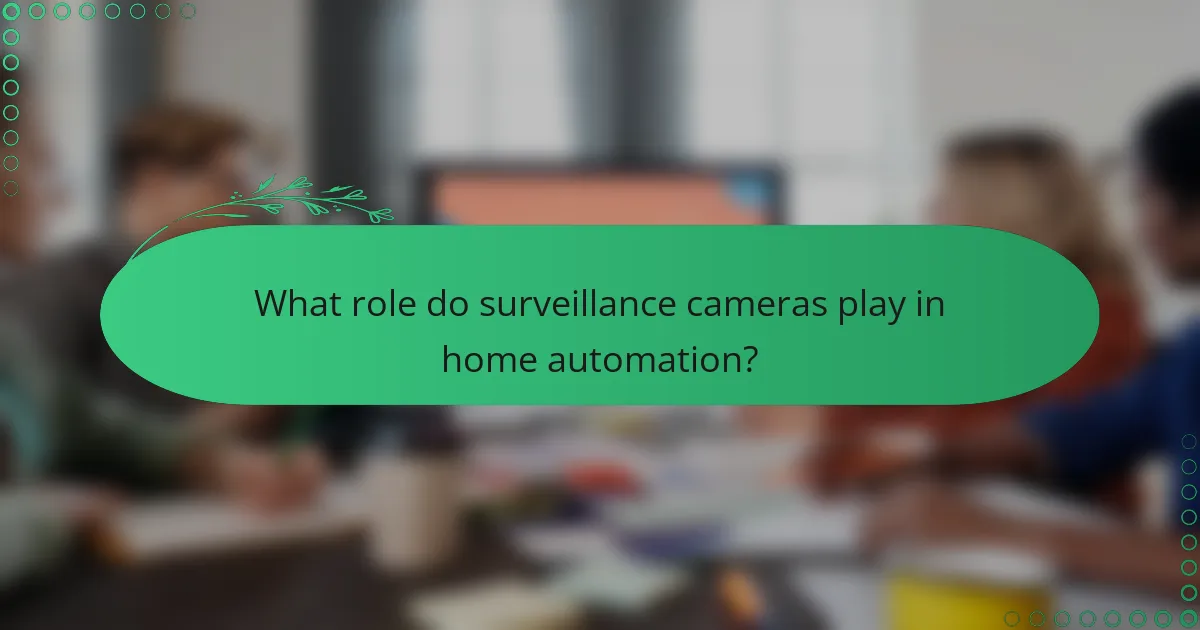
What role do surveillance cameras play in home automation?
Surveillance cameras are crucial in home automation systems as they enhance security by providing real-time monitoring and recording of activities around the property. They integrate seamlessly with other smart devices to offer homeowners greater control and peace of mind.
Real-time video streaming
Real-time video streaming allows homeowners to view live footage from their surveillance cameras through a smartphone or computer. This feature is essential for monitoring activities as they happen, enabling quick responses to any suspicious behavior.
When selecting a system, look for cameras that offer high-definition streaming, ideally in 1080p or higher, to ensure clarity. Additionally, consider systems that support multiple camera feeds to monitor different areas simultaneously.
Motion detection alerts
Motion detection alerts notify homeowners when movement is detected within the camera’s field of view. This feature is vital for identifying potential intruders or unusual activity, allowing for immediate action.
Choose cameras with customizable sensitivity settings to reduce false alarms caused by pets or passing vehicles. Many systems also allow users to set specific zones for motion detection, focusing on critical areas like entry points.
Cloud storage options
Cloud storage options provide a secure way to store video footage from surveillance cameras, ensuring that recordings are accessible even if the camera is damaged or stolen. This feature is particularly useful for reviewing past events or providing evidence if needed.
When evaluating cloud storage, consider the subscription costs and the amount of storage offered. Some systems provide free basic storage for a limited time, while others may charge monthly fees for extended access. Look for plans that fit your budget and storage needs, typically ranging from a few dollars to over twenty dollars per month.
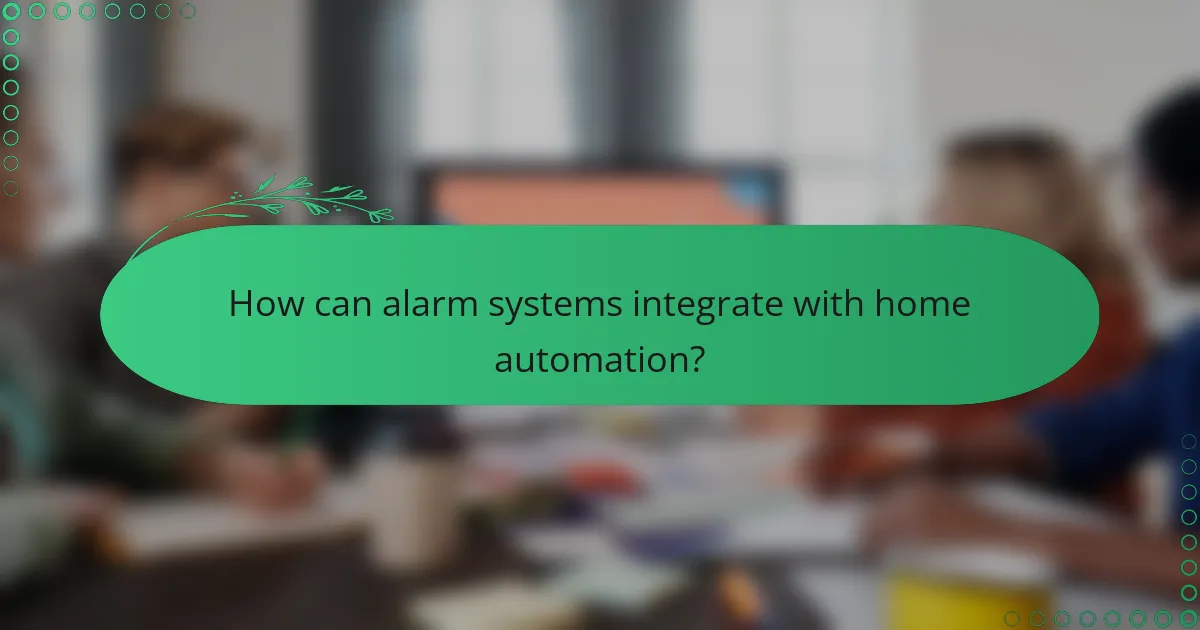
How can alarm systems integrate with home automation?
Alarm systems can seamlessly integrate with home automation by connecting various devices to enhance security and convenience. This integration allows for real-time monitoring, automated responses, and improved communication between systems.
Automated alerts
Automated alerts are essential for timely notifications regarding security events. When an alarm is triggered, the system can send alerts via SMS, email, or app notifications to homeowners and designated contacts. This ensures that you are informed immediately, allowing for quick action.
Consider setting up alerts for different scenarios, such as unauthorized entry, smoke detection, or water leaks. Customizing alert preferences can help prioritize which notifications are most critical to you.
Integration with smart devices
Integrating alarm systems with smart devices enhances overall home security and automation. Smart locks, cameras, and sensors can work together to create a cohesive security network. For instance, when an alarm is triggered, smart cameras can automatically start recording, providing visual evidence.
Ensure compatibility with popular smart home ecosystems like Google Home or Amazon Alexa. This allows for voice control and centralized management of your security devices, making it easier to monitor your home.
Emergency response features
Emergency response features are crucial for effective security systems. Many alarm systems can automatically contact local authorities or emergency services when an alarm is activated. This feature can significantly reduce response times in critical situations.
When choosing a system, look for options that offer professional monitoring services. These services can provide 24/7 surveillance and immediate action if an emergency arises, giving you peace of mind.
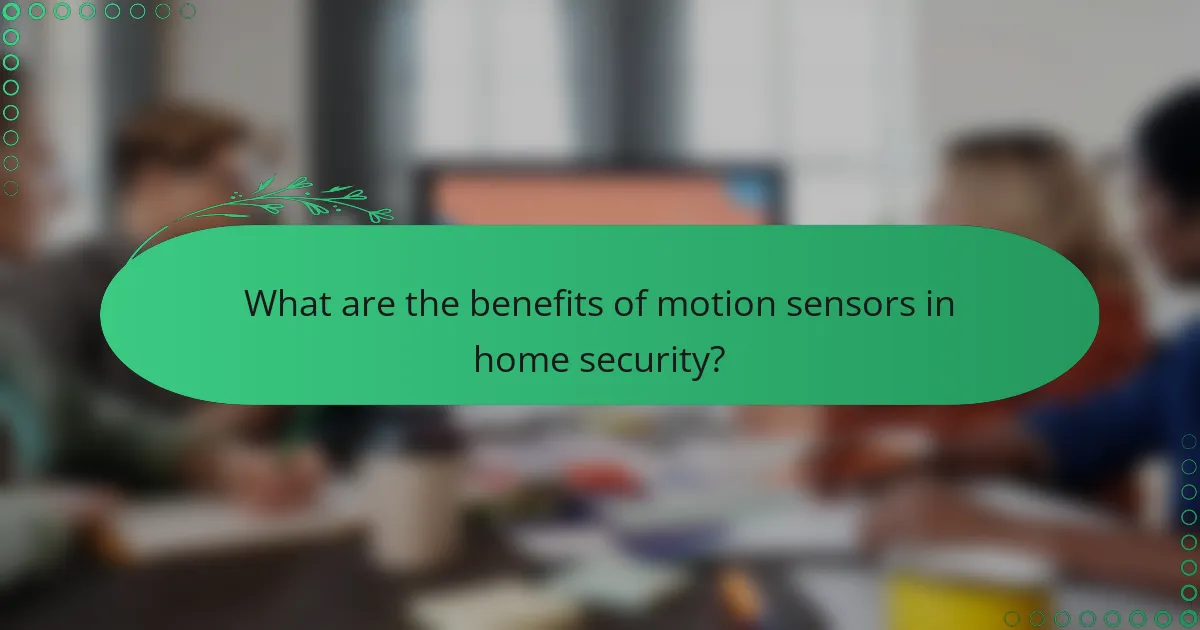
What are the benefits of motion sensors in home security?
Motion sensors enhance home security by detecting movement within designated areas, triggering alerts, and activating security systems. They provide an effective way to monitor property and deter potential intruders, making them a vital component of modern home automation systems.
Intruder detection
Motion sensors are primarily designed for intruder detection, alerting homeowners to any unauthorized movement. They use infrared technology to sense heat emitted by people or animals, ensuring quick identification of potential threats. Many systems can send real-time notifications to smartphones, allowing for immediate action.
When selecting motion sensors, consider their range and sensitivity settings. Most residential sensors cover areas between 30 to 50 feet, but some advanced models can detect motion up to 100 feet away. Proper placement is crucial; install them in entry points and high-traffic areas for optimal effectiveness.
Energy efficiency
Motion sensors contribute to energy efficiency by controlling lighting and HVAC systems based on occupancy. By automatically turning off lights and adjusting temperature settings when no one is present, they help reduce energy consumption and lower utility bills.
For example, integrating motion sensors with smart lighting can save up to 20-30% on electricity costs. Homeowners should look for sensors that can be programmed to suit their schedules and preferences, ensuring they only operate when needed.
Integration with lighting systems
Integrating motion sensors with lighting systems enhances both security and convenience. When motion is detected, lights can automatically illuminate pathways or entryways, providing visibility and deterring intruders. This feature is particularly useful for outdoor lighting around homes.
Consider using smart bulbs that can be controlled via a home automation app. This allows homeowners to customize the brightness and duration of lights triggered by motion sensors, creating a tailored experience that enhances safety and comfort.
